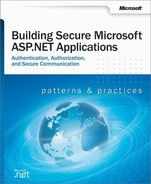U
- UDL files, connection strings in, Using DPAPI Directly from ASP.NET
- UDP (User Data Protocol), Authentication
- UNC (Universal Naming Convention) file shares, Secure Resources, Using the Original Caller
- unmanaged code, Security for Server and Library Applications
- URL authorization, More Information, Gatekeepers and Gates, Using .NET Roles, ASP.NET Security Architecture, ASP.NET Security Architecture, Windows Authentication with Impersonation, Configurable Security, Configurable Security, Configure ASP.NET Settings, Platform/Transport Security Architecture, Configurable Security, Configurable Security, ASP.NET and the HTTP Channel
- .NET remoting, ASP.NET and the HTTP Channel
- .NET roles and, Using .NET Roles
- ASP.NET security, More Information, Gatekeepers and Gates, ASP.NET Security Architecture, ASP.NET Security Architecture, Platform/Transport Security Architecture
- configuring, Configure ASP.NET Settings
- Forms authentication, Configurable Security
- Windows authentication with impersonation, Windows Authentication with Impersonation, Configurable Security
- Windows authentication without impersonation, Configurable Security, Configurable Security
- User Data Protocol (UDP), Authentication
- User Manager, Accessing Network Resources, Using the Anonymous Internet User Account, Using the ASP.NET Process Identity
- user names., The Foundations, Authentication, Authorize the User Based on User Name or Role Membership, Avoid Running as SYSTEM
- (see also )
- authentication and, The Foundations
- (see also )
- authorization and, Authorize the User Based on User Name or Role Membership
- for ASPNET account, Avoid Running as SYSTEM
- user profiles, Web Farm Considerations, Advantages, Storing Database Connection Strings Securely, Using DPAPI from Enterprise Services, Notes, Create a Windows Account to Run the Enterprise Services Application and Windows Service
- User Services layer, Logical Tiers
- user store, DPAPI with, Storing Database Connection Strings Securely, Machine Store vs. User Store, Machine Store vs. User Store, How To: Create a DPAPI Library, How To: Use DPAPI (User Store) from ASP.NET with Enterprise Services, How To: Use DPAPI (User Store) from ASP.NET with Enterprise Services, Notes, Why Use Enterprise Services?, Requirements, Requirements, Create a Serviced Component that Provides Encrypt and Decrypt Methods, Call the Managed DPAPI Class Library, Call the Managed DPAPI Class Library, Create a Windows Account to Run the Enterprise Services Application and Windows Service, Configure, Strong Name, and Register the Serviced Component, Create a Windows Service Application that will Launch the Serviced Component, Create a Windows Service Application that will Launch the Serviced Component, Write a Web Application to Test the Encryption and Decryption Routines
- (see also )
- calling managed DPAPI class library, Create a Serviced Component that Provides Encrypt and Decrypt Methods
- configuring, strong naming, and registering serviced component, Create a Windows Account to Run the Enterprise Services Application and Windows Service
- creating dummy class to launch serviced component, Call the Managed DPAPI Class Library
- creating serviced components with encryption and decryption methods, Requirements
- creating Web application to test encryption and decryption, Create a Windows Service Application that will Launch the Serviced Component
- creating Windows account for Enterprise Services application and Windows service, Call the Managed DPAPI Class Library
- creating Windows service to launch serviced component, Configure, Strong Name, and Register the Serviced Component
- Enterprise Services and, Machine Store vs. User Store
- installing and starting Windows service, Create a Windows Service Application that will Launch the Serviced Component
- issues, How To: Use DPAPI (User Store) from ASP.NET with Enterprise Services
- machine store vs., Storing Database Connection Strings Securely, How To: Create a DPAPI Library
- modifying Web application to read encrypted connection string from Web.config file, Write a Web Application to Test the Encryption and Decryption Routines
- requirements, Requirements
- using Enterprise Services, Notes
- using Windows service, Why Use Enterprise Services?
- user-defined database roles, Authorization
- users, The Foundations, The Foundations, Design Principles, Logical Tiers, Authentication, ASP.NET and HttpContext.User, An Authorization Pattern, Windows Authentication, Using a Serviced Component, Accessing Non-Windows Network Resources, Web Farm Considerations, Identifying Callers, Configure ASP.NET Settings, Advantages, Storing Database Connection Strings Securely, Using DPAPI from Enterprise Services, SQL Injection Attacks, Notes, Create a Windows Account to Run the Enterprise Services Application and Windows Service
- (see also , )
- accounts., ASP.NET and HttpContext.User (see )
- anonymous Internet account, Using a Serviced Component
- authenticating and authorizing, The Foundations
- (see also )
- identifying authenticated, Windows Authentication
- input., Design Principles (see )
- interactive, and Enterprise Services, Identifying Callers
- malicious Web, Accessing Non-Windows Network Resources, Configure ASP.NET Settings
- names., Authentication (see )
- profiles, Web Farm Considerations, Advantages, Storing Database Connection Strings Securely, Using DPAPI from Enterprise Services, Notes, Create a Windows Account to Run the Enterprise Services Application and Windows Service
- putting, into roles, An Authorization Pattern
- unfiltered input, SQL Injection Attacks
- User Services layer, Logical Tiers
- Users and Computers Administration tool, Register Serviced Components
..................Content has been hidden....................
You can't read the all page of ebook, please click here login for view all page.
